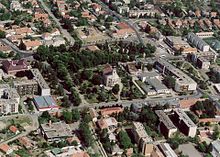Heves
| Heves | ||||
|
||||
| Basic data | ||||
|---|---|---|---|---|
| State : | Hungary | |||
| Region : | Northern Hungary | |||
| County : | Heves | |||
| Small area until December 31, 2012 : | Heves | |||
| Coordinates : | 47 ° 36 ' N , 20 ° 17' E | |||
| Area : | 99.31 km² | |||
| Residents : | 10,533 (Jan. 1, 2011) | |||
| Population density : | 106 inhabitants per km² | |||
| Telephone code : | (+36) 36 | |||
| Postal code : | 3360 | |||
| KSH kódja: | 14526 | |||
| Structure and administration (as of 2012) | ||||
| Community type : | city | |||
| Mayor : | Sándor Sveiczer (Fidesz-KDNP) | |||
| Postal address : | Erzsébet tér 2 3360 Heves |
|||
| Website : | ||||
| (Source: A Magyar Köztársaság helységnévkönyve 2011. január 1st at Központi statisztikai hivatal ) | ||||
Heves ( German : Hewesch ) is a city in the southeast of Heves County in Hungary . It is also the administrative seat of the small area of the same name (until 2012) and the district of Heves (from 2013). The city is located on the Kál-Kápolna – Kisújszállás railway line and on the national road 31 .
history
Under the reign of King I. Stephen were in Hungary counties built. So also in the area around the village. Hewes was first mentioned in 1203 . In 1271, Stephan V held a state parliament here. In 1467 the place received limited city rights. In the 15th century the prosperity ended with the conquest of Hatvan by the Turks in 1544. In 1567 the place and the surrounding villages were destroyed. The population was expelled in 1596 and Turks settled in the city. From 1685 to 1686 the city was occupied by imperial troops and finally liberated from the Turks in 1688. In the 18th century serfs came to Heves from Upper Hungary and the Bükk area . After the restructuring of agriculture in the 1860s, the Heves melon developed into a nationally recognized brand.
The growth of the city was stopped by the First World War . In the Second World War, 350 Jews were deported. From December 1944 to March 1945 the command of the III. Ukrainian front in Heves. In 1984 the place received city rights.
population
In 2001, 96.5 percent of the population were Hungarians, 3 percent Roma and 0.5 percent Slovak .
economy
From an economic point of view, Heves is a lagging area with high unemployment. The city lives mainly from agriculture. The city is best known for its melon cultivation. Other fruits (apple, peach, cherry, plum), sunflower, wheat, barley and corn are also grown. Pigs, poultry, cattle, sheep, horses and rabbits are kept. With the system change from 1989, mechanical engineering disappeared. In part, this resulted in light industry. Service industries and trade are on average developed in the city. There are only small businesses in the food industry. Tourism is developing due to the proximity of Lake Tisza .
traffic
The towns of Pély , Eger , Gyöngyös , Jászberény and Kisköre can be reached by regional bus transport . Long-distance buses go to Budapest , Debrecen , Gyula , Szeged , Tiszafüred , and Eger.
Culture, education, sport
In Heves there are four kindergartens and five general education schools (grades 1 to 8), one vocational school, one technical middle school and one grammar school as well as a boarding school. The city is the adult education center for the southern part of the county.
In the city there is the cultural center "Zsigmond Móricz" and the city library with 12,000 volumes. The Heves Wind and Dance Association and the Heves Chamber Choir enrich musical life. Events of the Hungarian Academy of Fine Arts take place regularly .
The football department of the Hevesi LSC currently plays in the third division.
Attractions
- Roman Catholic Church (partly Gothic)
- Protected puszta
- Chess museum
- Exhibition site of the Heves Museum
- The castles of Básty-Újfalussy, Remenyik and Halász
sons and daughters of the town
- Ludwig Hevesi (1843–1910), writer and journalist
- Lajos Czeizler (1893–1969), football coach
- István Beöthy (1897–1961), sculptor and architect
- István Nagy (* 1959), track and field athlete
Town twinning
-
 Breganze , Italy
Breganze , Italy
-
 Miercurea Ciuc , Romania
Miercurea Ciuc , Romania
-
 Ciumani , Romania
Ciumani , Romania
-
 Aalburg , Netherlands (from 1993 to 2007)
Aalburg , Netherlands (from 1993 to 2007)



